To move goods from UK & Ireland to Spain, go ro-ro-rail with Brittany Ferries
-
 Fabrice Turquet - Mr Ro-Ro Rail for Brittany Ferries
Fabrice Turquet - Mr Ro-Ro Rail for Brittany Ferries
-
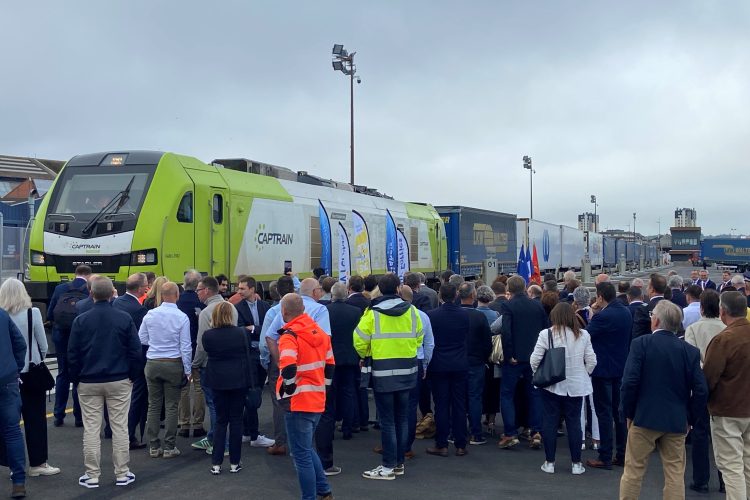 17 July - first arrival into Cherbourg with French minister
17 July - first arrival into Cherbourg with French minister
-
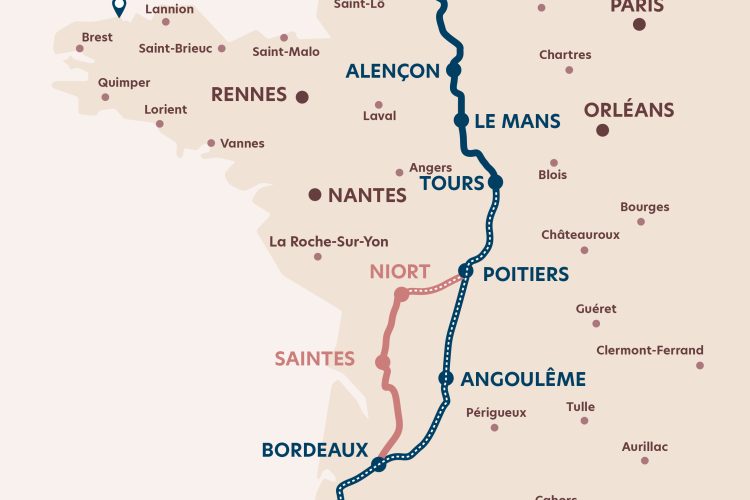 Ro-ro-rail route map
Ro-ro-rail route map
-
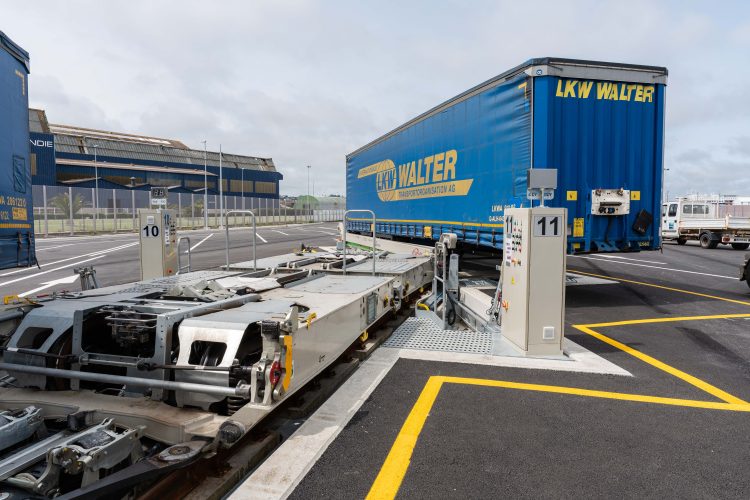 Pivoting pockets - image Jess Breheret
Pivoting pockets - image Jess Breheret
-
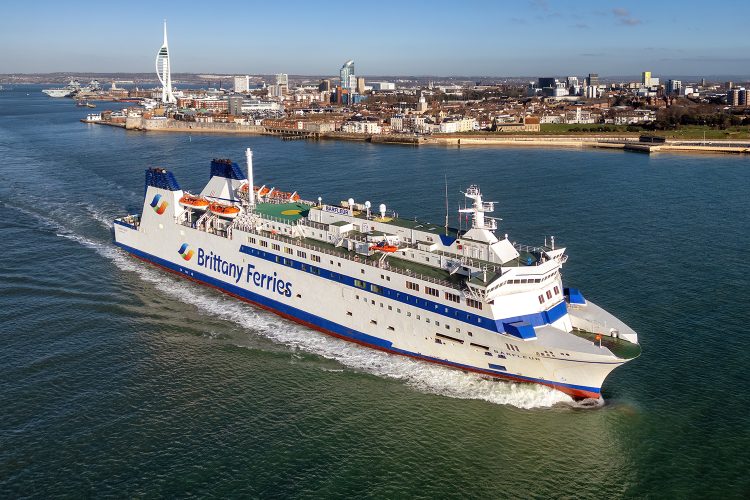 Brittany Ferries Barfleur - Poole to Cherbourg
Brittany Ferries Barfleur - Poole to Cherbourg
-
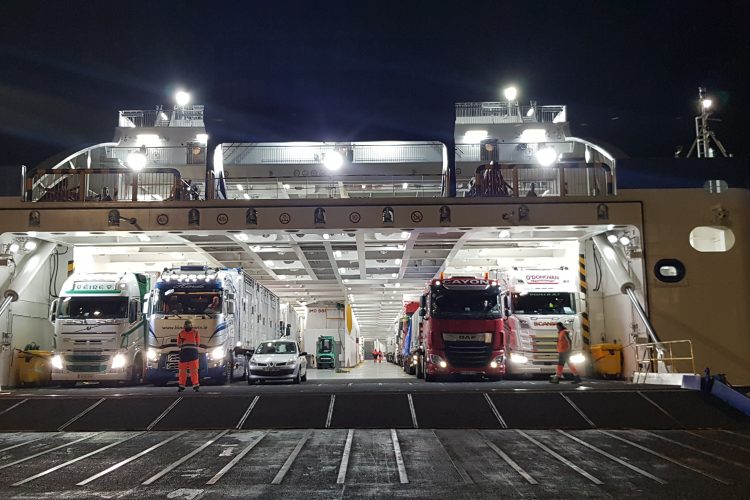 Freight loading in Rosslare
Freight loading in Rosslare
Brittany Ferries is taking loads off roads. This week in Cherbourg (17 July) it inaugurated a 970km (600 miles) rail link that connects the port on France’s north-western coast with Bayonne on the French/Spanish border. Never before has the French company launched a route on land. But the new train service means freight and logistics operators can send trailers by sea-and-rail, from the UK and Ireland without the need for an accompanying driver.
The service is described as ro-ro-rail, because the trailer sails across the Channel by roll-on roll-off ferry before transferring seamlessly to France’s rail network, or vice-versa. Benefits include being quicker, cheaper and greener than travelling by road. It also meets growing demand for transport of trailer-only freight transport.
“2025 is the year of decarbonisation for Brittany Ferries,” said Jean-Marc Roué, president of Brittany Ferries at the launch in Cherbourg. “The two largest hybrid ferries in the European Union joined our fleet in spring, powered by LNG, and electricity. Now we have a multimodal motorway linking Ireland and the United Kingdom with Spain by rail and sea. We are turning a new. sustainable page in the Brittany Ferries story. It is increasingly ambitious but still rooted in the economic vitality of the regions we serve. It starts with Cherbourg and its port, an economic and tourist hub for our company, and gateway to a region loved by British and Irish holiday makers alike.”
In a ro-ro-rail voyage, trailers are first delivered to ports like Poole or Portsmouth on the UK’s south coast, or to Rosslare in Ireland. They are then transported onto ferries by yard tractors called tugs. Following the voyage to France, these driverless loads are disembarked by tug before being loaded onto the train in Cherbourg.
The transfer of wagons from tarmac to rail comes courtesy of French rail technology manufacturer MODALOHR’s double-ladle wagons. Each wagon can accommodate two trailers and is fitted with so-called ‘pivoting pockets’. These shift 45 degrees to allow a trailer and tug to access the wagon. When in place, the tug withdraws, the pocket with trailer atop swivels back in line. And the train prepares for departure.
Trailers are whisked overnight by rail to Bayonne. There, they are collected by a driver to an onward destination in the Iberian Peninsula or south of France.
The service is operated by two trainsets, each comprising a maximum 18 wagons (accommodating up to 36 trailers), which run on 970km of the SNCF Réseau rail network. Following a soft launch in June, the service has already garnered strong interest among large and small companies.
One service, for example, carried 22 trailers heading north from Bayonne to Cherbourg. Its cargo included tyres and car parts, clothing and perfumes.
Brittany Ferries says it plans to increase the number of services from four in each direction every week to five by the end of the year, rising to a daily return service in 2026. It adds that Ro-ro-rail aligns with the French government’s aspiration to modernise and decarbonise freight transport, and to promote multi-modal networks.
Philippe Tabarot French minister for transport was among dignitaries in Cherbourg for the inauguration event. “By launching an additional transport link from Cherbourg, the new rail terminal strengthens the strategic position of French ports in European freight operations,” he told guests. “This multimodal network, operated by Brittany Ferries, is also a pioneering service. It is the first to transport non-accompanied trailers on the Atlantic arc, a major freight traffic corridor. While helping reduce CO₂ emissions by shifting traffic to rail and sea, the service will also relieve congestion on roads, thereby contributing to more sustainable logistics.”
There are many benefits of taking loads off roads, as the minister noted. One of the most important for Brittany Ferries and customers is environmental. Trucks will no longer be at the mercy of traffic and delays on the French road network and there will be far fewer emissions as a consequence. Brittany Ferries estimates a saving of one tonne of CO2 for every trailer carried by rail, compared with it travelling by road. It also reduces wear and tear on truck and trailer.
Brittany Ferries hopes to reduce by 25,000 the number of heavy goods vehicles on French roads, saving emissions, noise congestion and reducing the likelihood of accidents. It adds that it is continuing to reflect growing demand from hauliers to reduce costs, driver hours and helps address the international driver shortage, by moving trailers without accompaniment.
“Adding rail to the Brittany Ferries portfolio is a natural progression of what we have done for the last 53 years,” added Frédéric Pouget, Brittany Ferries director ports and operations. “We have seen a surge in transport of driverless loads, which means trailers travelling on ships without tractor units and drivers.
“We are responding to this demand, extending services across the spine of Western France, in addition to those that we offer by sea across the Atlantic arc. What we have to offer is the greenest and most efficient way to transport goods. For Brittany Ferries 2025 is truly the year of decarbonisation and multi-modal delivery.”
Looking to the months and years ahead, improvements to rail lines and enlargements to tunnels will allow an even more optimal rail route, and the use of greener electric-powered trains.
Hauliers can book their space on the new service now by calling Brittany Ferries freight reservations teams:
- UK & Ireland: Freight Reservations: +44 (0)330 159 5000 //[email protected] : Réservation Fret France +33 (0)2 33 88 44 33 // [email protected]
- Spain & Portugal : +34 944 947 367 // [email protected]
—Ends—
Timetable:
CHERBOURG TO MOUGUERRE |
MOUGUERRE TO CHERBOURG |
|
||||
Date period |
Departure |
Depart |
Arrive |
Departure |
Depart |
Arrive |
2nd July 2025 to 2nd August 2025 |
Monday |
Monday |
19h01 |
11h06 |
||
Tuesday |
19h20 |
12h04 |
Tuesday |
19h20 |
11h06 |
|
Wednesday |
Wednesday |
|||||
Thursday |
19h20 |
12h04 |
Thursday |
19h20 |
11h06 |
|
Friday |
19h20 |
12h04 |
Friday |
19h01 |
11h06 |
|
Saturday |
Saturday |
|||||
Sunday |
18h47 |
12h04 |
Sunday |
|||
Date period |
Departure |
Depart |
Arrive |
Departure |
Depart |
Arrive |
3rd August 2025 to 23rd August 2025 |
Monday |
Monday |
||||
Tuesday |
Tuesday |
|||||
Wednesday |
THREE |
|
Wednesday |
THREE |
||
Thursday |
WEEK |
|
Thursday |
WEEK |
||
Friday |
PAUSE |
Friday |
PAUSE |
|||
Saturday |
Saturday |
|||||
Sunday |
Sunday |
|||||
Date period |
Departure |
Depart |
Arrive |
Departure |
Depart |
Arrive |
24th August 2025 to 13th December 2025 |
Monday |
Monday |
19h01 |
11h06 |
||
Tuesday |
19h20 |
12h04 |
Tuesday |
19h20 |
11h06 |
|
Wednesday |
19h20 |
12h04 |
Wednesday |
19h01 |
11h06 |
|
Thursday |
19h20 |
12h04 |
Thursday |
19h01 |
11h06 |
|
Friday |
19h20 |
11h06 |
Friday |
19h01 |
11h06 |
|
Saturday |
Saturday |
|||||
Sunday |
18h47 |
12h04 |
Sunday |
|||
Date period |
Departure |
Depart |
Arrive |
Departure |
Depart |
Arrive |
| From 14th December 2025 |
Monday |
19h26 |
10h36 |
Monday |
19h07 |
11h55 |
Tuesday |
19h26 |
10h36 |
Tuesday |
19h07 |
11h55 |
|
Wednesday |
19h26 |
10h36 |
Wednesday |
19h07 |
11h55 |
|
Thursday |
19h26 |
10h36 |
Thursday |
19h07 |
11h55 |
|
Friday |
19h26 |
10h36 |
Friday |
19h07 |
11h55 |
|
Saturday |
19h26 |
10h36 |
Saturday |
19h07 |
11h55 |
|
Sunday |
Sunday |
|||||
 News
News